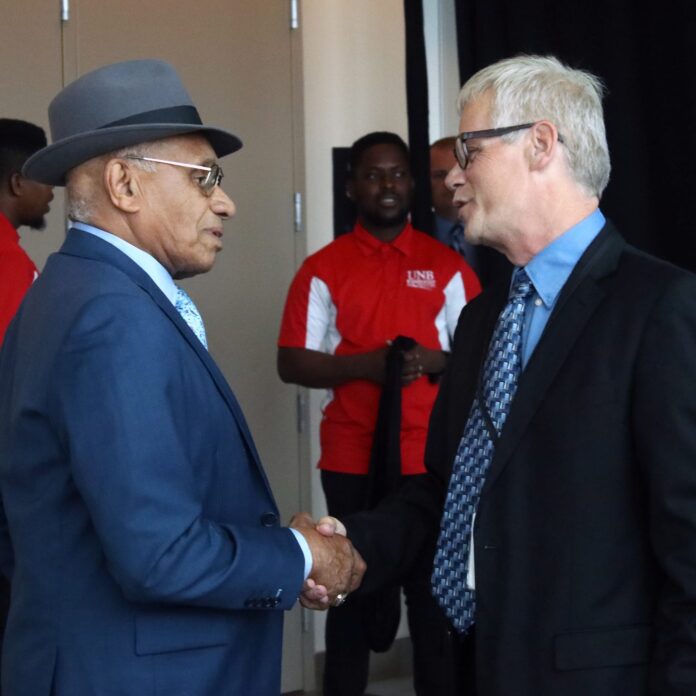

For current, retired and aspiring journalists, the communications field is a constantly evolving one. This past summer, the federal government passed Bill C-18, the Online News Act, which was an attempt to promote compensation for journalists whose media was being shared on platforms such as Google and Meta. The response from Meta means that in Canada, Canadian news cannot be shared on social media platforms such as Facebook and Instagram.
Related: Bill C-18 University Publications caught in the ‘crossfire’
This is just one of journalism’s current obstacles and experienced journalists are noticing another large change in sports journalism.
Bruce Hallihan worked for The Daily Gleaner in Fredericton for just over 34 years until 2022, including as Sports Editor for part of that time.
A graduate of the now-defunct communication arts program at NBCC Woodstock, Hallihan went back to his hometown of Miramichi to work before moving to The Daily Gleaner in 1988.
“I got a call from one of my former journalism profs and she said ‘there’s a job opening at The Gleaner for sports, you should apply,’” said Hallihan. ”I said ‘when’s the deadline?’ She said: ‘tomorrow.’”
When Hallihan first started, he wrote for various sections, before honing down on sports for most of his career. At the beginning, The Gleaner would have five to six pages of thorough sports coverage. Now, the newspaper is down to just one or two.
Today, Hallihan works as an Internal Communications Advisor for the Government of New Brunswick.
“It became so discouraging for me at the end of my career, because you invest all this 30 plus years into it and then all of a sudden this is being taken away, by first broadening your job, but also the lack of space for sports to begin with,” he said.
Hallihan, along with his coworker Bill Hunt, covered the professional leagues down to small local sports events, with the latter garnering the most attention from the local community.
“People look for those stories from local teams and athletes because that was our bread and butter,” he said.
Hallihan sees the future of journalism as being in other forms of media, such as podcasts. One local podcast, Late Scratches, is one that he listens to every week. The physical publication of newspapers is perhaps not far away from becoming completely obsolete, he said. The Daily Gleaner is down to just three physical publications a week, compared to six when he first started.
For Hallihan, the transition has been a realization that much of his identity is tied up with sports and sports journalism.
“People see me at the farmers market and say ‘I like what you wrote in your column, I don’t like it, whatever it might be,’” he said. “So much of your identity is tied up to sports, right?”
Despite the many changes, there is still a future for sports journalism, he said.
“There’s still stories to be told,” said Hallihan. “There’s still games being played.”
Bill Hunt worked alongside Hallihan for over thirty years at The Daily Gleaner after graduating from Algonquin College in Ottawa. He moved out east after working for an afternoon paper going through a transition period.
“The future of sports journalism, it’s pretty dire, I think,” said Hunt.
He covered everything sports, from game recaps to human interest stories of athletes perseverance through difficult times. Him and Hallihan agreed that the most impactful were those of human interest.
“I’ve been to thousands of games and I can honestly not tell you the details of any particular game I covered,” he said. “It was the personalities and people that you met along the way.”
One of his favourite memories in the sports journalism sphere was covering a story on the University of New Brunswick REDS men’s goalie Gene Chiarello, who was diagnosed with a malignant brain tumour and told he would have a short amount of time to live. Instead, he went through intense chemotherapy and made a comeback to the team, before becoming a lawyer and starting a family.
Another, helping to put together a proposal for Frederictonian Willie O’Ree to be inducted into the Hockey Hall of Fame as a Builder, which ultimately led to an induction for O’Ree in 2018.
Over the years though, Hunt describes the sports journalism landscape as one that is changing dramatically.
“I never would have predicted that Twitter and live streaming would be as big as it is,” he said. “It’s just a lot more active and a lot more interactive.”
With the use of social media platforms, if your story is 15 minutes late, it’s old news, said Hunt. However, the marketing side of sports is booming and Hunt has his eye on leagues such as the Professional Women’s Hockey League and the Women’s National Basketball Association as potential careers for aspiring sports journalists.
“There’s lots of jobs there, that league is going to wind up expanding, I’m sure,” said Hunt.
For the uncertain future, Hunt maintained the same outlook as Hallihan, that there are still stories to be told, regardless of the form of delivery.
“The technology is going to change and evolve, but you still need the human element,” he said. “There still needs to be humans to go get it.”
